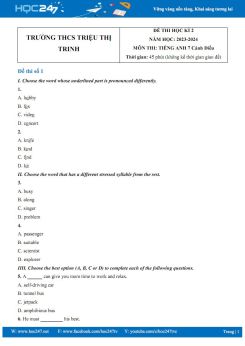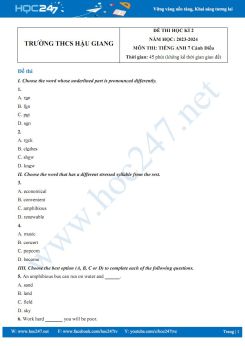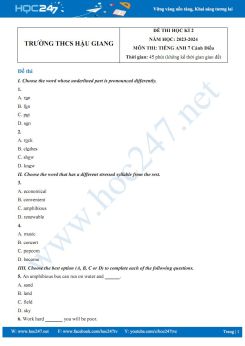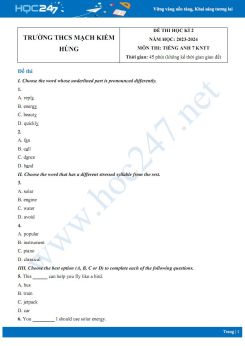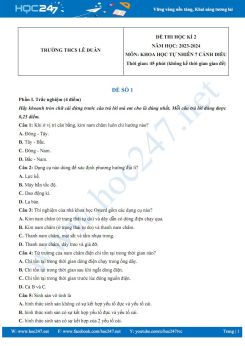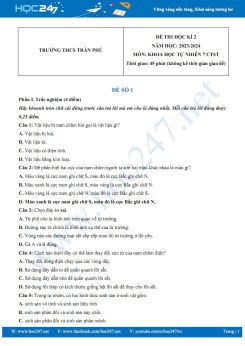Với mong muốn giúp các em có thêm nhiều nguồn tài liệu để ôn tập thật tốt cho kỳ thi Học kì 2 sắp tới, Ban biên tập HOC247 xin giới thiệu nội dung tài liệu Đề cương ôn tập HK2 môn Tiếng Anh 7 Cánh Diều năm 2023-2024. Mời các em tham khảo nội dung tài liệu dưới đây.
1. Tóm tắt kiến thức
1.1. Articles (Mạo từ)
|
a |
an |
the |
|
- Dùng cho danh từ đếm được số ít, bắt đầu bằng một phụ âm, chỉ một sự vật ngẫu nhiên. Ví dụ: a mango, a potato - Dùng trong các cụm từ chỉ lượng. Ví dụ: a bowl of rice, a cup of tea. - Dùng trong số đếm. Ví dụ: a hundred, a million |
- Dùng cho danh từ đếm được số ít, bắt đầu bằng một nguyên âm (trong cách đọc chứ không phải trong cách viết). Ví dụ: an onion, an apple, an hour |
- Dùng được cho cả danh từ đếm được số ít và số nhiều. - Dùng với danh từ chỉ sự duy nhất. - Dùng cho danh từ cụ thể mà người nói và người nghe đều biết hoặc đều hiểu. Ví dụ: the Earth, the flowers on the table |
♦ Các trường hợp không dùng mạo từ
- Khi danh từ số nhiều được dùng với nghĩa chung chung.
Ví dụ: Cats have water. / Women are fighting for equality.
- Khi trước danh từ là tính từ sở hữu.
Ví dụ: Her children are very nice.
1.2. Yes/ No questions (Câu hỏi Yes/No)
- Câu hỏi Yes/No cần câu trả lời hoặc là Yes hoặc là No.
- Chúng ta hình thành câu hỏi Yes/No với một trợ động từ (be, do hoặc have) hoặc với động từ khuyết thiếu. Chúng ta đặt trợ động từ hoặc động từ khuyết thiếu trước chủ ngữ.
|
Be/ Do/ Have/ Modals + S + (V)…? |
Ví dụ: Are you eating moon cakes? – Yes, I am.
(Bạn đang ăn bánh trung thu à? – Vâng.)
+ Did they eat moon cakes at the festival last year? – No, they didn’t.
(Họ đã ăn bánh trung ở lễ hội năm ngoái à? – Không.)
+ Can he eat all these moon cakes? – Yes, he can.
(Anh ấy có thể ăn tất cả bánh trung thu này không? – Vâng, anh ấy có thể.)
- Chúng ta không sử dụng trợ động từ khi chúng ta sử dụng “be” như động từ chính.
Ví dụ: Is that your Christmas present? – Yes, it is.
(Kia là quà Giáng sinh của bạn à? – Đúng vậy.)
1.3. Preposition of time (Giới từ chỉ thời gian)
1.3.1. Although/ Though (Mặc dù)
Chúng ta sử dụng although/ though trước một mệnh đề để kết nối hai ý kiến trái ngược nhau trong cùng một câu.
Ví dụ: Although/ Though John Peter is an amateur actor, he gave a great performance in his latest film.
= John Peter gave a great performance in his latest film although/ though he is an amateur actor.
(John Peter đã diễn xuất tuyệt vời trong bộ phim mới nhất của mình mặc dù anh ấy là diễn viên nghiệp dư.)
1.3.2. However (Tuy nhiên)
Chúng ta sử dụng however để thể hiện sự tương phản ý kiến trong hai câu. Chúng ta thường sử dụng dấu phẩy sau however.
Ví dụ:
John Peter is an amateur actor. However, he gave a great performance in his latest film.
(John Peter là diễn viên nghiệp dư. Tuy nhiên, anh ấy đã thể hiện xuất sắc trong bộ phim mới nhất của mình.)
1.4. Possessive pronouns (Đại từ sở hữu)
Đại từ sở hữu = tính từ sở hữu + danh từ. Đại từ sở hữu đóng vai trò như một danh từ có thể làm chủ ngữ hoặc tân ngữ trong câu.
|
Đại từ đóng vai trò chủ ngữ |
Đại từ đóng vai trò chủ ngữ |
|
I (tôi) you (bạn) we (chúng tôi) they (họ) he (anh ấy) she (cô ấy) it (nó) you (các bạn) |
mine (của tôi) yours (của bạn) ours (của chúng tôi) theirs (của họ) his (của anh ấy) hers (của cô ấy) its (của nó) yours (của các bạn) |
Ví dụ:
- This is your bicycle. That bicycle is hers. (= her bicycle)
(Đây là xe đạp của bạn. Xe đạp kia là của cô ấy.)
- Your bicycle is blue and mine (= my bicycle) is red.
(Xe đạp của bạn màu xanh lam và của tôi màu đỏ.)
- My bus was late. Yours (= your bus) was on time.
(Xe buýt của tôi thì muộn. Xe buýt của bạn thì đúng giờ.)
1.5. Review tenses (Ôn tập thì)
1.5.1. The future simple (Thì Tương lai đơn)
|
Công thức |
Cách dùng |
Ví dụ |
|
(+) S + be + going to + V0 (-) S + be + not + going to + V0 (?) Be + S + going to + V0?
|
Diễn tả dự đoán có sơ sở. |
The sky is very black. It is going to rain. |
|
Dùng để diễn tả một dự định, kế hoạch trong tương lai. |
He is going to marry this year. |
|
|
Dấu hiệu nhận biết Trong câu có những từ, cụm từ như: tomorrow, next (week, month, year, Monday,...), in + [thời gian trong tương lai], two weeks from now, in the future, soon, one day,... |
||
1.5.2. Present Continuous (Thì Hiện tại tiếp diễn)
|
Công thức |
Cách dùng |
Ví dụ |
|
(+) S + am/is/are + Ving (-) S + am/is/are + not + Ving (?) Am/Is/Are + S + Ving?
|
Diễn tả một hành động đang diễn ra tại thời điểm nói. |
He is going home. |
|
Diễn tả sự việc xảy ra trái với lệ thường. |
Every morning, I go to school by bike, but today I’m going on foot. |
|
|
Diễn tả một hành động sắp xảy ra theo kế hoạch đã định trước. |
I bought a ticket two days ago. I’m watching a movie in the cinema tomorrow. |
|
|
Diễn tả sự việc lặp đi lặp lại gây khó chịu. Câu này mang tính than phiền, phàn nàn, có động từ chỉ tần suất kèm theo. |
He is always coming late. |
|
|
Mô tả cái gì đó đổi mới, phát triển hơn. |
The children are growing quickly. |
|
|
Dấu hiệu nhận biết Trong câu xuất hiện các từ, các cụm từ như: now, right now, at present, at the moment, at this time, it’s + giờ cụ thể + now. Trong câu có các động từ đi kèm với dấu chấm than (!): Look!, Watch!, Listen!, Keep silent!,... |
||
Quy tắc thêm đuôi “ing” vào sau động từ
- Với đa số động từ, ta chỉ cần thêm "ing": work → working, watch → watching
- Với động từ kết thúc bằng "e", ta bỏ "e" và thêm "ing": dance → dancing, live → living
- Nếu động từ có một âm tiết kết thúc bằng một phụ âm và trước nó là nguyên âm, ta nhân đôi phụ âm cuối đó và thêm "ing": sit → sitting, swim → swimming
- Nếu động từ có hai âm tiết và trọng âm ở âm tiết thứ 2, kết thúc bằng một phụ âm và trước nó là nguyên âm, ta nhân đôi phụ âm cuối và thêm "ing": begin → beginning
- Nếu động từ kết thúc bằng "w, x, y" và trước nó là nguyên âm, ta chỉ cần thêm
"ing" mà không nhân đôi phụ âm: play → playing, fix → fixing, row → rowing
2. Trắc nghiệm tự luyện
Exercise 1: Match the first halves in culumn A with the second ones in column B to make sentences
|
A |
B |
|
1. The “festival of lights” is 2. He used to go to school on foot 3. We must always obey traffic 4. Wait for the traffic light to turn green 5. The boy was so frightened by the film |
a. when he was at primary school. b. before you cross the street. c. another name for Diwali. d. that he couldn’t sleep last night. e. for our safety |
1. The “festival of lights” is ______.
2. He used to go to school on foot ______.
3. We must always obey traffic ______.
4. Wait for the traffic light to turn green ______.
5. The boy was so frightened by the film ______.
Exercise 2: Write “although/ despite/ in spite of” to complete the sentences.
1. ________________ she has a good look, everybody hates her.
2. Jane seldom sees Jim ______they go to the same school.
3. ________________ her illness, Jane went to work yesterday.
4. ________________ it was chilly outside, we went fishing.
5. ________________ working hard, Peter failed the test.
6. ________________ the difficulties, Sarah managed to solve the problem.
7. My grandfather was very strong __________his old age.
8. The children slept deeply ________________ the noise.
9. ________________ the high salary, Marey refused the job offer.
10. ________________earning a high salary, Sara never wastes her money.
Exercise 3: Write the correct form of the word given
1. Coal will be ________________by another renewable source of energy in the future. (REPLACE)
2. Natural gas is ________________and it is harmful to the environment. (LIMIT)
3. I like solar energy because it is ________________ (PLENTY)
4. Using public transport can reduce ________________ (POLLUTE)
5. These types of energy do not cause pollution or waste ________________resources. (NATURE)
6. We hope that by using solar energy, the problem of energy ________________will be solved. (SHORT)
7. This new plant is being built to provide ________________for the population of the local area. (ELECTRIC)
8. Remember to turn off the lights when________________to bed, boy! (GO)
9. She wears a sweater to keep her body________________in the early winter. (WARMTH)
10. What are the advantages and ________________of using public transport? (ADVANTAGE)
Exercise 4: Rewrite the sentences without changing the meaning
1. I spend 15 minutes walking from here to my school
It ________________________________________________________________
2. Ny house is not far from your house
It ________________________________________________________________
3. You can come there by bus.
You ______________________________________________________________
4. My house is about 3 km from the National Library
It ________________________________________________________________
5. What is the distance between the board and the first student’s desk?
How ______________________________________________________________
6. Is the movie theater far from the restaurant?
It ________________________________________________________________
Exercise 5: Read the passage and decide whether the statements are TRUE (T) or FALSE (F).
Flying cars aren’t just science fiction anymore. Terrafugia, based in the United States, is developing a readable aircraft called the Transition. The vehicle has two seats, four wheels and wings that fold up, so it can be driven like a car. Terrafugia first began to work on the Transition in 2006 and has come closer than anyone to making the flying car a reality. The company uses special tires and glass that are lighter than normal automotive ones, which makes it easier for the vehicle to fly. An owner needs to pass a test and complete 20 hours of flying time to be able to fly the Transition. The Transition can reach around 70 miles per hour (mph) on the road and 115 mph in the air. On the ground, it gets 35 miles per gallon.
1. The Transition has room for four passengers.
2. Terrafugia has worked on the Transition since 2006.
3. The flying car uses special tires and glass.
4. All drivers of the Transition will only have to pass a test to get a license.
5. The Transition will go faster in the air than on the road.
Trên đây là toàn bộ nội dung tài liệu Đề cương ôn tập HK2 môn Tiếng Anh 7 Cánh diều năm 2023-2024. Để xem thêm nhiều tài liệu tham khảo hữu ích khác các em chọn chức năng xem online hoặc đăng nhập vào trang hoc247.net để tải tài liệu về máy tính.
Mời các em tham khảo tài liệu có liên quan:
- Bộ đề thi HK2 môn Tiếng Anh 7 Cánh Diều năm 2023-2024 có đáp án Trường THCS Triệu Thị Trinh
- Đề thi HK2 môn Tiếng Anh 7 Cánh Diều năm 2023-2024 có đáp án Trường THCS Hậu Giang
Hy vọng tài liệu này sẽ giúp các em học sinh ôn tập tốt và đạt thành tích cao trong kì thi sắp tới.






